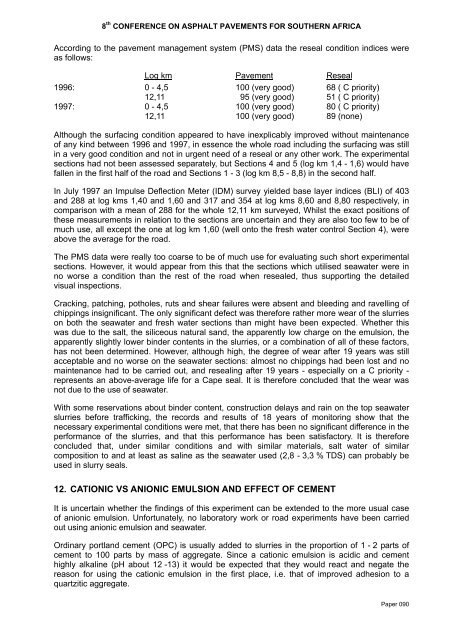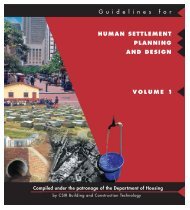Use of Seawater in Slurry of Cape Seal - CSIR
Use of Seawater in Slurry of Cape Seal - CSIR
Use of Seawater in Slurry of Cape Seal - CSIR
You also want an ePaper? Increase the reach of your titles
YUMPU automatically turns print PDFs into web optimized ePapers that Google loves.
8 th CONFERENCE ON ASPHALT PAVEMENTS FOR SOUTHERN AFRICAAccord<strong>in</strong>g to the pavement management system (PMS) data the reseal condition <strong>in</strong>dices wereas follows:Log km Pavement Reseal1996: 0 - 4,5 100 (very good) 68 ( C priority)12,11 95 (very good) 51 ( C priority)1997: 0 - 4,5 100 (very good) 80 ( C priority)12,11 100 (very good) 89 (none)Although the surfac<strong>in</strong>g condition appeared to have <strong>in</strong>explicably improved without ma<strong>in</strong>tenance<strong>of</strong> any k<strong>in</strong>d between 1996 and 1997, <strong>in</strong> essence the whole road <strong>in</strong>clud<strong>in</strong>g the surfac<strong>in</strong>g was still<strong>in</strong> a very good condition and not <strong>in</strong> urgent need <strong>of</strong> a reseal or any other work. The experimentalsections had not been assessed separately, but Sections 4 and 5 (log km 1,4 - 1,6) would havefallen <strong>in</strong> the first half <strong>of</strong> the road and Sections 1 - 3 (log km 8,5 - 8,8) <strong>in</strong> the second half.In July 1997 an Impulse Deflection Meter (IDM) survey yielded base layer <strong>in</strong>dices (BLI) <strong>of</strong> 403and 288 at log kms 1,40 and 1,60 and 317 and 354 at log kms 8,60 and 8,80 respectively, <strong>in</strong>comparison with a mean <strong>of</strong> 288 for the whole 12,11 km surveyed, Whilst the exact positions <strong>of</strong>these measurements <strong>in</strong> relation to the sections are uncerta<strong>in</strong> and they are also too few to be <strong>of</strong>much use, all except the one at log km 1,60 (well onto the fresh water control Section 4), wereabove the average for the road.The PMS data were really too coarse to be <strong>of</strong> much use for evaluat<strong>in</strong>g such short experimentalsections. However, it would appear from this that the sections which utilised seawater were <strong>in</strong>no worse a condition than the rest <strong>of</strong> the road when resealed, thus support<strong>in</strong>g the detailedvisual <strong>in</strong>spections.Crack<strong>in</strong>g, patch<strong>in</strong>g, potholes, ruts and shear failures were absent and bleed<strong>in</strong>g and ravell<strong>in</strong>g <strong>of</strong>chipp<strong>in</strong>gs <strong>in</strong>significant. The only significant defect was therefore rather more wear <strong>of</strong> the slurrieson both the seawater and fresh water sections than might have been expected. Whether thiswas due to the salt, the siliceous natural sand, the apparently low charge on the emulsion, theapparently slightly lower b<strong>in</strong>der contents <strong>in</strong> the slurries, or a comb<strong>in</strong>ation <strong>of</strong> all <strong>of</strong> these factors,has not been determ<strong>in</strong>ed. However, although high, the degree <strong>of</strong> wear after 19 years was stillacceptable and no worse on the seawater sections: almost no chipp<strong>in</strong>gs had been lost and noma<strong>in</strong>tenance had to be carried out, and reseal<strong>in</strong>g after 19 years - especially on a C priority -represents an above-average life for a <strong>Cape</strong> seal. It is therefore concluded that the wear wasnot due to the use <strong>of</strong> seawater.With some reservations about b<strong>in</strong>der content, construction delays and ra<strong>in</strong> on the top seawaterslurries before traffick<strong>in</strong>g, the records and results <strong>of</strong> 18 years <strong>of</strong> monitor<strong>in</strong>g show that thenecessary experimental conditions were met, that there has been no significant difference <strong>in</strong> theperformance <strong>of</strong> the slurries, and that this performance has been satisfactory. It is thereforeconcluded that, under similar conditions and with similar materials, salt water <strong>of</strong> similarcomposition to and at least as sal<strong>in</strong>e as the seawater used (2,8 - 3,3 % TDS) can probably beused <strong>in</strong> slurry seals.12. CATIONIC VS ANIONIC EMULSION AND EFFECT OF CEMENTIt is uncerta<strong>in</strong> whether the f<strong>in</strong>d<strong>in</strong>gs <strong>of</strong> this experiment can be extended to the more usual case<strong>of</strong> anionic emulsion. Unfortunately, no laboratory work or road experiments have been carriedout us<strong>in</strong>g anionic emulsion and seawater.Ord<strong>in</strong>ary portland cement (OPC) is usually added to slurries <strong>in</strong> the proportion <strong>of</strong> 1 - 2 parts <strong>of</strong>cement to 100 parts by mass <strong>of</strong> aggregate. S<strong>in</strong>ce a cationic emulsion is acidic and cementhighly alkal<strong>in</strong>e (pH about 12 -13) it would be expected that they would react and negate thereason for us<strong>in</strong>g the cationic emulsion <strong>in</strong> the first place, i.e. that <strong>of</strong> improved adhesion to aquartzitic aggregate.Paper 090
















